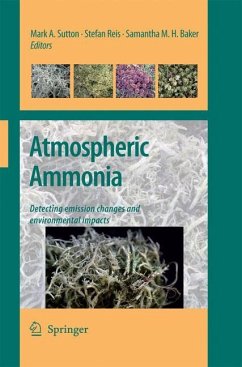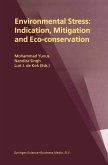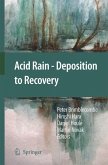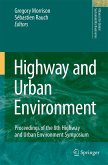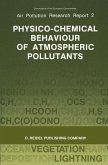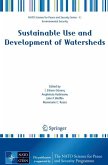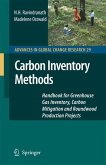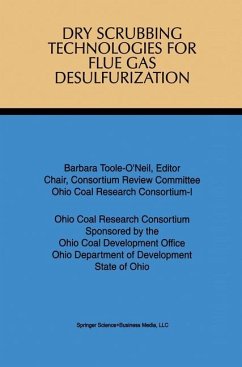Atmospheric Ammonia
Detecting emission changes and environmental impacts. Results of an Expert Workshop under the Convention on Long-range Transboundary Air Pollution
Herausgegeben:Sutton, Mark; Reis, Stefan; Baker, Samantha
Atmospheric Ammonia
Detecting emission changes and environmental impacts. Results of an Expert Workshop under the Convention on Long-range Transboundary Air Pollution
Herausgegeben:Sutton, Mark; Reis, Stefan; Baker, Samantha
- Broschiertes Buch
- Merkliste
- Auf die Merkliste
- Bewerten Bewerten
- Teilen
- Produkt teilen
- Produkterinnerung
- Produkterinnerung
Anthropogenic emissions of ammonia cause a host of environmental impacts, including loss of biodiversity, soil acidification and formation of particulate matter in the atmosphere. Under the auspices of the UNECE Convention on Long Range Transboundary Air Pollution, around 80 international experts met to review the state of scientific knowledge. This book reports their analysis. It concludes that threshold levels for ammonia effects have been underestimated and sets new values, it assesses the independent evidence to verify reported reductions in regional ammonia emissions, and it reviews the…mehr
Andere Kunden interessierten sich auch für
![Environmental Stress: Indication, Mitigation and Eco-conservation Environmental Stress: Indication, Mitigation and Eco-conservation]() Environmental Stress: Indication, Mitigation and Eco-conservation112,99 €
Environmental Stress: Indication, Mitigation and Eco-conservation112,99 €![Acid Rain - Deposition to Recovery Acid Rain - Deposition to Recovery]() Peter Brimblecombe / Hiroshi Hara / Daniel Houle / Martin Novak (eds.)Acid Rain - Deposition to Recovery113,99 €
Peter Brimblecombe / Hiroshi Hara / Daniel Houle / Martin Novak (eds.)Acid Rain - Deposition to Recovery113,99 €![Highway and Urban Environment Highway and Urban Environment]() Gregory M. Morrison / Sébastien Rauch (eds.)Highway and Urban Environment150,99 €
Gregory M. Morrison / Sébastien Rauch (eds.)Highway and Urban Environment150,99 €![Physico-Chemical Behaviour of Atmospheric Pollutants Physico-Chemical Behaviour of Atmospheric Pollutants]() Physico-Chemical Behaviour of Atmospheric Pollutants39,99 €
Physico-Chemical Behaviour of Atmospheric Pollutants39,99 €![Sustainable Use and Development of Watersheds Sustainable Use and Development of Watersheds]() Sustainable Use and Development of Watersheds223,99 €
Sustainable Use and Development of Watersheds223,99 €![Carbon Inventory Methods Carbon Inventory Methods]() N.H. RavindranathCarbon Inventory Methods149,99 €
N.H. RavindranathCarbon Inventory Methods149,99 €![Dry Scrubbing Technologies for Flue Gas Desulfurization Dry Scrubbing Technologies for Flue Gas Desulfurization]() Dry Scrubbing Technologies for Flue Gas Desulfurization150,99 €
Dry Scrubbing Technologies for Flue Gas Desulfurization150,99 €-
-
-
Anthropogenic emissions of ammonia cause a host of environmental impacts, including loss of biodiversity, soil acidification and formation of particulate matter in the atmosphere. Under the auspices of the UNECE Convention on Long Range Transboundary Air Pollution, around 80 international experts met to review the state of scientific knowledge. This book reports their analysis. It concludes that threshold levels for ammonia effects have been underestimated and sets new values, it assesses the independent evidence to verify reported reductions in regional ammonia emissions, and it reviews the uncertainties in modelling ammonia, both in "hot spots" and at the regional scale.
Produktdetails
- Produktdetails
- Verlag: Springer / Springer Netherlands
- Artikelnr. des Verlages: 978-94-007-8953-1
- 2009
- Seitenzahl: 492
- Erscheinungstermin: 12. September 2014
- Englisch
- Abmessung: 235mm x 155mm x 27mm
- Gewicht: 747g
- ISBN-13: 9789400789531
- ISBN-10: 940078953X
- Artikelnr.: 41630670
- Herstellerkennzeichnung
- Springer-Verlag GmbH
- Tiergartenstr. 17
- 69121 Heidelberg
- ProductSafety@springernature.com
- Verlag: Springer / Springer Netherlands
- Artikelnr. des Verlages: 978-94-007-8953-1
- 2009
- Seitenzahl: 492
- Erscheinungstermin: 12. September 2014
- Englisch
- Abmessung: 235mm x 155mm x 27mm
- Gewicht: 747g
- ISBN-13: 9789400789531
- ISBN-10: 940078953X
- Artikelnr.: 41630670
- Herstellerkennzeichnung
- Springer-Verlag GmbH
- Tiergartenstr. 17
- 69121 Heidelberg
- ProductSafety@springernature.com
Mark Sutton Is a specialist in the behaviour of ammonia in the atmosphere, based at the NERC Centre for Ecology and Hydrology, Edinburgh. He is the coordinator of the NitroEurope Integrated Project, chairman of the European Centre of the International Nitrogen Initiative and co-chair of the UNECE Task Force on Reactive Nitrogen. Stefan Reis Is an expert on emissions of atmospheric pollutants and integrated assessment modelling. Formerly of the Institute of Energy Economics and the Rational Use of Energy at the University of Stuttgart, Germany, he is now the Scientific Project Manager of the NitroEurope Integrated Project. Samantha Baker Is a scientific policy analyst at the UK Department for Environment Food and Rural Affairs (Defra), with extensive experience of transboundary air pollution issues. She and a member of the Natural Resource and Rural Affairs (NRRA) Science Division at Defra and co-chairs the Projections Panel of the UNECE Task Force on Emission Inventories and Projections.
Ammonia Critical Thresholds.- Reassessment of Critical Levels for Atmospheric Ammonia.- Potential for the Further Development and Application of Critical Levels to Assess the Environmental Impacts of Ammonia.- Long-Term Cumulative Exposure Exacerbates the Effects of Atmospheric Ammonia on an Ombrotrophic Bog: Implications for Critical Levels.- The Application of Transects to Assess the Effects of Ammonia on Woodland Groundflora.- Estimation of the Ammonia Critical Level for Epiphytic Lichens Based on Observations at Farm, Landscape and National Scales.- Mapping Ammonia Emissions and Concentrations for Switzerland - Effects on Lichen Vegetation.- Over Which Averaging Period is the Ammonia Critical Level Most Precautionary?.- Macrolichens on Twigs and Trunks as Indicators of Ammonia Concentrations Across the UK - a Practical Method.- Assessment of Critical Levels of Atmospheric Ammonia for Lichen Diversity in Cork-Oak Woodland, Portugal.- Temporal Trends in Atmospheric Ammonia.- Linking Ammonia Emission Trends to Measured Concentrations and Deposition of Reduced Nitrogen at Different Scales.- Long-Term Record (1981-2005) of Ammonia and Ammonium Concentrations at K-Puszta Hungary and the Effect of Sulphur Dioxide Emission Change on Measured and Modelled Concentrations.- Assessment of Ammonia and Ammonium Trends and Relationship to Critical Levels in the UK National Ammonia Monitoring Network (NAMN).- Review of Published Studies Estimating the Abatement Efficacy of Reduced-Emission Slurry Spreading Techniques.- Analysis of Ammonia Hotspots.- Ammonia Deposition Near Hot Spots: Processes, Models and Monitoring Methods.- Standardised Grasses as Biomonitors of Ammonia Pollution Around Agricultural Point Sources.- Soluble Ammonium in Plants as a Bioindicator forAtmospheric Nitrogen Deposition: Refinement and Testing of a Practical Method.- Spatial Planning as a Complementary Tool to Abate the Effects of Atmospheric Ammonia Deposition at the Landscape Scale.- Regional Modelling of Atmospheric Ammonia.- Modelling of the Atmospheric Transport and Deposition of Ammonia at a National and Regional Scale.- Application of a Lagrangian Model FRAME to Estimate Reduced Nitrogen Deposition and Ammonia Concentrations in Poland.- Application of the EMEP Unified Model to the UK with a Horizontal Resolution of 5 × 5 km2.- Conclusions and Outlook.- Critical Levels for Ammonia.- Detecting Change in Atmospheric Ammonia Following Emission Changes.- Assessment Methods for Ammonia Hot-Spots.- Modelling the National and Regional Transport and Deposition of Ammonia.- Reliability of Ammonia Emission Estimates and Abatement Efficiencies.- Ammonia Policy Context and Future Challenges.- Synthesis and Summary for Policy Makers.
Ammonia Critical Thresholds.- Reassessment of Critical Levels for Atmospheric Ammonia.- Potential for the Further Development and Application of Critical Levels to Assess the Environmental Impacts of Ammonia.- Long-Term Cumulative Exposure Exacerbates the Effects of Atmospheric Ammonia on an Ombrotrophic Bog: Implications for Critical Levels.- The Application of Transects to Assess the Effects of Ammonia on Woodland Groundflora.- Estimation of the Ammonia Critical Level for Epiphytic Lichens Based on Observations at Farm, Landscape and National Scales.- Mapping Ammonia Emissions and Concentrations for Switzerland - Effects on Lichen Vegetation.- Over Which Averaging Period is the Ammonia Critical Level Most Precautionary?.- Macrolichens on Twigs and Trunks as Indicators of Ammonia Concentrations Across the UK - a Practical Method.- Assessment of Critical Levels of Atmospheric Ammonia for Lichen Diversity in Cork-Oak Woodland, Portugal.- Temporal Trends in Atmospheric Ammonia.- Linking Ammonia Emission Trends to Measured Concentrations and Deposition of Reduced Nitrogen at Different Scales.- Long-Term Record (1981-2005) of Ammonia and Ammonium Concentrations at K-Puszta Hungary and the Effect of Sulphur Dioxide Emission Change on Measured and Modelled Concentrations.- Assessment of Ammonia and Ammonium Trends and Relationship to Critical Levels in the UK National Ammonia Monitoring Network (NAMN).- Review of Published Studies Estimating the Abatement Efficacy of Reduced-Emission Slurry Spreading Techniques.- Analysis of Ammonia Hotspots.- Ammonia Deposition Near Hot Spots: Processes, Models and Monitoring Methods.- Standardised Grasses as Biomonitors of Ammonia Pollution Around Agricultural Point Sources.- Soluble Ammonium in Plants as a Bioindicator forAtmospheric Nitrogen Deposition: Refinement and Testing of a Practical Method.- Spatial Planning as a Complementary Tool to Abate the Effects of Atmospheric Ammonia Deposition at the Landscape Scale.- Regional Modelling of Atmospheric Ammonia.- Modelling of the Atmospheric Transport and Deposition of Ammonia at a National and Regional Scale.- Application of a Lagrangian Model FRAME to Estimate Reduced Nitrogen Deposition and Ammonia Concentrations in Poland.- Application of the EMEP Unified Model to the UK with a Horizontal Resolution of 5 × 5 km2.- Conclusions and Outlook.- Critical Levels for Ammonia.- Detecting Change in Atmospheric Ammonia Following Emission Changes.- Assessment Methods for Ammonia Hot-Spots.- Modelling the National and Regional Transport and Deposition of Ammonia.- Reliability of Ammonia Emission Estimates and Abatement Efficiencies.- Ammonia Policy Context and Future Challenges.- Synthesis and Summary for Policy Makers.

